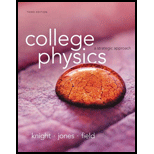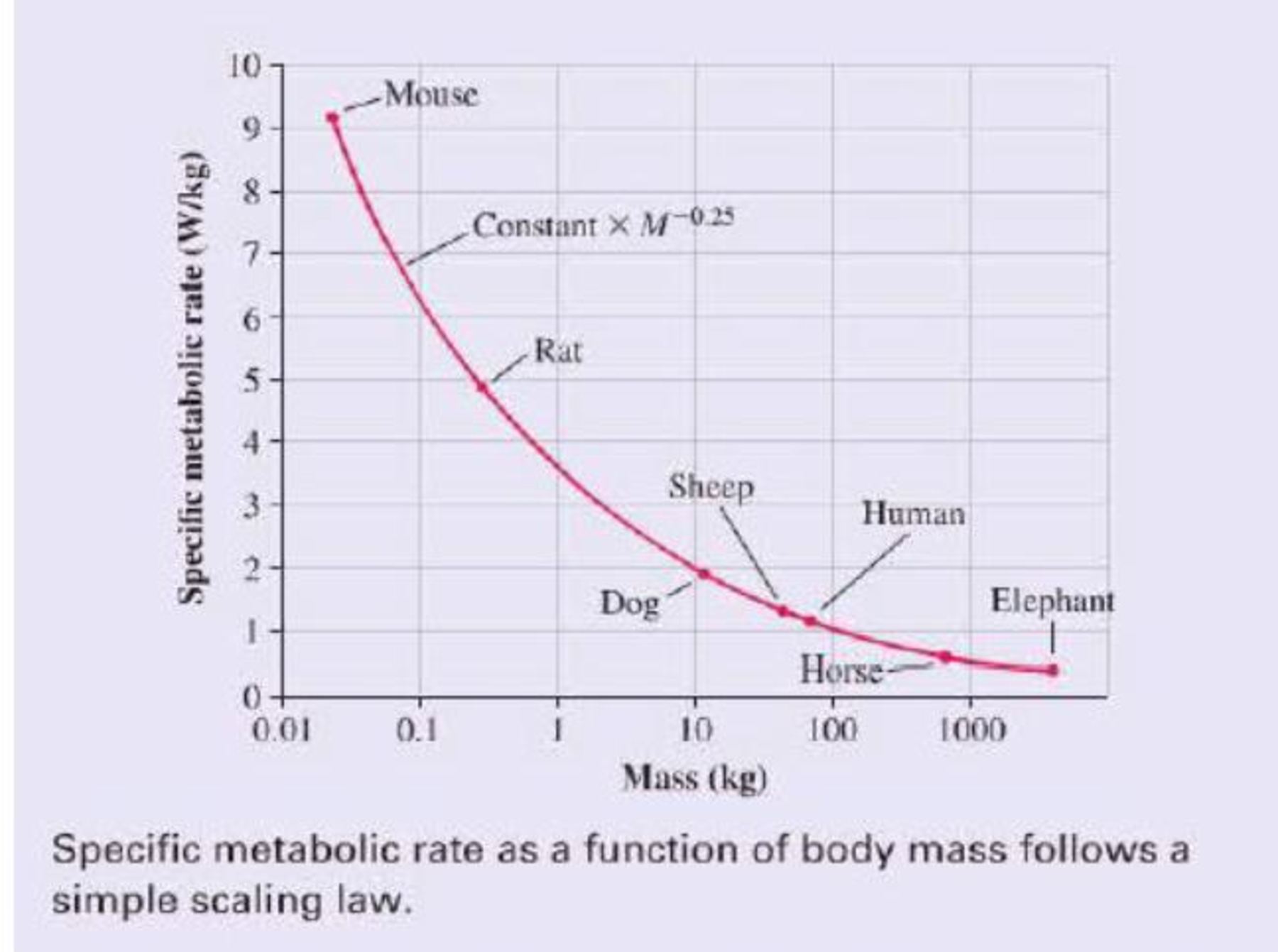
Concept explainers
Size and Life
Physicists look for simple models and general principles that underlie and explain diverse physical phenomena. In the first 13 chapters of this textbook, you’ve seen that just a handful of general principles and laws can be used to solve a wide range of problems. Can this approach have any relevance to a subject like biology? It may seem surprising, but there are general 'laws of biology“’ that apply, with quantitative accuracy, to organisms as diverse as elephants and mice.
Let’s look at an example. An elephant uses more metabolic power than a mouse. This is not surprising, as an elephant is much bigger. But recasting the data shows an interesting trend. When we looked at the energy required to raise the temperature of different substances, we considered specific heat. The “specific” meant that we considered the heat required for 1 kilogram. For animals, rather than metabolic rate, we can look at the specific metabolic rate, the metabolic power used per kilogram of tissue. If we factor out the mass difference between a mouse and an elephant, are their specific metabolic powers the same?
In fact, the specific metabolic rate varies quite a bit among mammals, as the graph of specific metabolic rate versus mass shows. But there is an interesting trend: All of the data points lie on a single smooth curve. In other words, there really is a biological law we can use to predict a mammal’s metabolic rate knowing only its mass M. In particular, the specific metabolic rate is proportional to M –0.25. Because a 4000 kg elephant is 160,000 times more massive than a 25 g mouse, the mouse’s specific metabolic power is (160,000)0.25 = 20 times that of the elephant. A law that shows how a property scales with the size of a system is called a scaling law.

A similar scaling law holds for birds, reptiles, and even bacteria. Why should a single simple relationship hold true for organisms that range in size from a single cell to a 100 ton blue whale? Interestingly, no one knows for sure. It is a matter of current research to find out just what this and other scaling laws tell us about the nature of life.
Perhaps the metabolic-power scaling law is a result of
If heat dissipation were the only factor limiting metabolism, we can show that the specific metabolic rate should scale as M–0.33quite different from the M–0.25 scaling observed. Clearly, another factor is at work. Exactly what underlies the M–0.25 scaling is still a matter of debate, but some recent analysis suggests the scaling is due to limitations not of heat transfer but of fluid flow. Cells in mice, elephants, and all mammals receive nutrients and oxygen for metabolism from the bloodstream. Because the minimum size of a capillary is about the same for all mammals, the structure of the circulatory system must vary from animal to animal. The human aorta has a diameter of about 1 inch; in a mouse, the diameter is approximately l/20th of this. Thus a mouse has fewer levels of branching to smaller and smaller blood vessels as we move from the aorta to the capillaries. The smaller blood vessels in mice mean that viscosity is more of a factor throughout the circulatory system. The circulatory system of a mouse is quite different from that of ail elephant.
A model of specific metabolic rate based on blood-flow limitations predicts a M–0.25 law, exactly as observed. The model also makes other testable predictions. For example, the model predicts that the smallest possible mammal should have a body mass of about 1 gram—exactly the size of the smallest shrew. Even smaller animals have different types of circulatory' systems; in the smallest animals, nutrient transport is by diffusion alone. But the model can be extended to predict that the specific metabolic rate for these animals will follow a scaling law similar to that for mammals, exactly as observed. It is too soon to know if this model will ultimately prove to be correct, but it’s indisputable that there are large-scale regularities in biology that follow mathematical relationships based on the laws of physics.
The following questions are related to the passage "Size and Life" on the previous page.
A typical timber wolf has a mass of 40 kg, a typical jackrabbit a mass of 2.5 kg. Given the scaling law presented in the passage, we’d expect the specific metabolic rate of the jackrabbit to be higher by a factor of
- A. 2
- B. 4
- C. 8
- D. 16
Want to see the full answer?
Check out a sample textbook solution
Chapter P Solutions
College Physics: A Strategic Approach (3rd Edition)
Additional Science Textbook Solutions
An Introduction to Thermal Physics
Essential University Physics: Volume 1 (3rd Edition)
University Physics with Modern Physics (14th Edition)
Physics for Scientists and Engineers: A Strategic Approach with Modern Physics (4th Edition)
Lecture- Tutorials for Introductory Astronomy
Physics for Scientists and Engineers: A Strategic Approach, Vol. 1 (Chs 1-21) (4th Edition)
- Suppose your hair grows at the rate of 1/32 inch per day. Find the rate at which it grows in nanometers per second. Because the distance between atoms in a molecule is on the order of 0.1 nm, your answer suggests how rapidly atoms are assembled in this protein synthesis.arrow_forwardKinetic energy K (Chapter 7) has dimensions kg m2/s2. It can be written in terms of the momentum p (Chapter 9) and mass m as K=p22m (a) Determine the proper units for momentum using dimensional analysis. (b) The unit of force is the newton N, where 1 N = 1 kg m/s2. What are the units of momentum p in terms of a newton and another fundamental SI unit?arrow_forwardMust a complex system be adaptive to be of interest in the field of complexity? Give an example to support your answer.arrow_forward
- Integrated Concepts Large meteors sometimes strike the Earth, converting most of their kinetic energy into thermal energy. (a) What is the kinetic energy of a 109kg meteor moving at 25.0km/s ? (b) If this meteor lands in a deep ocean and 80% of its kinetic energy goes into heating water, how many kilograms of water could it raise by 5.0C ? (c) Discuss how the energy of the meteor is more likely to be deposited in the ocean and the likely effects of that energy.arrow_forwardKont Swim, who is taking Physics for the third year in a row (and not because he likes it), la rowed his boat within three foot of the dock, Kont decides to jump onto the dock and tum around and dock his boat. Explain to Kent why this docking strategy is not a good shalogyarrow_forwardA team in a Marshmellow challenge built a thrity inch tall structure in eighteen minutes. What is the average building speed of the team in inches per second? What will be the average speed in meters per second?arrow_forward
- Please help me with the following and explain making sure the answer is really really correct 100%. I tried all kinds of calculations and it was wrong so I have no idea what's wrong. When I look at similar questions with different numbers it was 0. ... so i guess it has be something similar maybe but pleas make sure your work is correct pls pls ( wrong asnwer--> 1.31g and 1.35e-12)arrow_forwardWrite an explanation or narration about the given problem why the problem got these answers shown in the photos. Narrate the solution in the given picture below. The narration must include the following parts: 1. Dissect the problem by explaining the illustration 2. Identify the given variables and the required ones 3. Explain the solution 4. Double check the solution by explaining why the values makes sense or using another way to verify the answer. Problem: (The answer to this question is in the given picture) When a 58-g tennis ball is served, it accelerates from rest to a speed of 45 m/s. The impact with the racket gives the ball a constant acceleration over a distance of 44 cm. What is the magnitude of the net force acting on the ball?arrow_forwardKinetic energy KE (Chapter 5) has dimensions kgm2/s2. It can be written in terms of the momentum p (Chapter 6) and mass m as KE = p2/2m (a) Determine the proper units for momentum (p) using dimensional analysis. (b) Refer to Problem 2. Given the units of force, write a simple equation relating a constant force F exerted on an object, an interval of time t during which the force is applied, and the resulting momentum of the object, p.arrow_forward
- Please explain how to work out this problem. The correct answer is selected, I just don't understand how to get to that answer. I'm also confused by the unit conversions, so please emphasize that if you can. Thank you.arrow_forwardI need to understand how to solve this problem step by step please teach mearrow_forward"Painting the entire exterior surface of a cube with edge length S = 1.26 meters reduces paint level by 2 inches in a cylindrical paint can with radius R = 3.24 inches. Assuming the paint is put on with a uniform thickness, calculate this thickness in inches." Hmm... I don't think the paint can height is necessary... at least, it wasn't given in the problem. I started out by calculating the volume of the 2 inches removed from the can, and, knowing that the volume would stay the same, tried to figure out how to put the volume onto the surface of the cube. That's where I got stuck. Any ideas? Thank you!arrow_forward

 College PhysicsPhysicsISBN:9781938168000Author:Paul Peter Urone, Roger HinrichsPublisher:OpenStax College
College PhysicsPhysicsISBN:9781938168000Author:Paul Peter Urone, Roger HinrichsPublisher:OpenStax College Glencoe Physics: Principles and Problems, Student...PhysicsISBN:9780078807213Author:Paul W. ZitzewitzPublisher:Glencoe/McGraw-Hill
Glencoe Physics: Principles and Problems, Student...PhysicsISBN:9780078807213Author:Paul W. ZitzewitzPublisher:Glencoe/McGraw-Hill Physics for Scientists and Engineers, Technology ...PhysicsISBN:9781305116399Author:Raymond A. Serway, John W. JewettPublisher:Cengage Learning
Physics for Scientists and Engineers, Technology ...PhysicsISBN:9781305116399Author:Raymond A. Serway, John W. JewettPublisher:Cengage Learning College PhysicsPhysicsISBN:9781285737027Author:Raymond A. Serway, Chris VuillePublisher:Cengage Learning
College PhysicsPhysicsISBN:9781285737027Author:Raymond A. Serway, Chris VuillePublisher:Cengage Learning College PhysicsPhysicsISBN:9781305952300Author:Raymond A. Serway, Chris VuillePublisher:Cengage Learning
College PhysicsPhysicsISBN:9781305952300Author:Raymond A. Serway, Chris VuillePublisher:Cengage Learning





